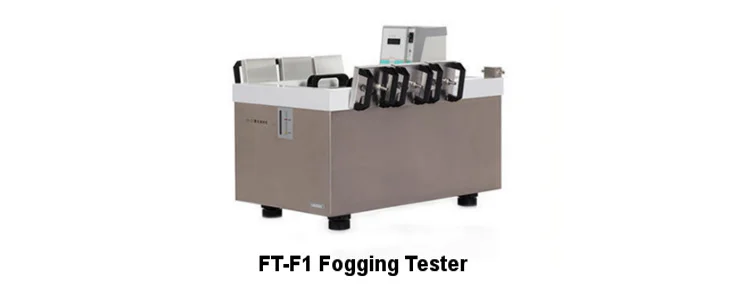
Through fogging test to materials of auto's inner decoration, volatile substances of those materials can be controlled so as to effectively lower the environmental contamination inside cars. Therefore, fogging test has become an important means for automotive manufacturers as well as auto's inner decoration manufacturers to control product quality.
At present, relevant domestic and international fogging test standards for auto's inner decoration altogether involve three kinds of test methods: the reflectometric method, the gravimetric method and the haze method. These standards and their relevant testing methods are as follows:
| Standards | Issue time | Test methods | Note |
|---|---|---|---|
| DIN 75201 | 1992 | Reflectometric method, gravimetric method | |
| SAE J1756 | 1994 | Reflectometric method, gravimetric method | |
| ISO 6452 | 2000 | Reflectometric method, gravimetric method | |
| QB/T 2728 | 2005 | Reflectometric method, gravimetric method | |
| NES M0161 | Haze method | ||
| ES-X83231 | Haze method, gravimetric method |
The figure below is the structural representation of fogging device in fogging test. A sample is placed under specimen presser at the bottom of a glass beaker, which is immersed in a constant temperature oil bath. The beaker is covered with oil and higher temperature resistant fluorine seal ring, with fogging carrier (position G), filter paper, cooling plate placed above sequentially. The substances emitted from the leather sample under heat condense on the cooling plate.
Except for position G, test equipments for these three methods are the same. For reflectometric and hazing method, the G part is a fogging glass plate. Test results are obtained through measuring the opaqueness or fogging value of the glass plate before and after test. In Gravimetric method, position G is an aluminum foil with a little bigger circular glass plate 3 mm in thickness placed above. Test results of this method are obtained through measuring the quantity of condensate that formed on a cold surface.
So long as constant high temperature bath and cooling plate can work under required temperature, fogging process of the test does not require high on external environment. Environment has no effects on it fundamentally. However, fogging carriers, such as aluminum foil or glass plate, have strict requirements on environment and even the slightest change will produce great influence.
In Almost all standards, fog-formed glass plate is required to be placed under a temperature of 23oC ± 2oC and conditioned under the humidity of 50% ± 5%RH in a windless and sunless environment. Fogging carrier has some condensed water inevitably. Environmental temperature and humidity, which are difficult to be controlled efficiently, are of vital importance to water evaporation. The uncertainty of environmental control will directly affect accuracy of final testing results.
In standards DIN 75201, ISO 6452 and QB/T 2728, it is specified that fog-formed aluminum foil should be conditioned in desiccators. In this case, users only need to take environmental temperature into condensation and need not consider humidity and gas flow any more. Consequently, conditioning environment of fog-formed aluminum foil is more easily controlled.
Since fogging test is complex in operation procedures and is easily subject to environment variation, the three standards, DIN 75201, ISO 6452 and QB/T 2728, provide the same calibration method to evaluate the correctness of final test results.
For reflectometric method, 10 ± 0.1g DIDP are put into the beaker that is immersed in 100oC constant temperature bath; the cool plate is 21oC; and the final result should be within 77 ± 3%. Otherwise, the test is regarded as unsuccessful. Users should find out the reason and re-test.
In gravimetric method, 10 ± 0.1g DOP are put into the beaker that is immersed in 100oC constant temperature bath; the cool plate is 21oC, and the final results should be within 4.9 ± 0.25mg. Otherwise the test is regarded as unsuccessful. Users should Find out the reason and retest.
For haze method, no calibration method has been provided in the above-mentioned standards.
The table below is a comparison of the items of the three methods
| Fogging test method | Reflectometric method | Gravimetric method | Haze method | Notes |
|---|---|---|---|---|
| Devices to be cleaned | Beaker, specimen presser, seal ring, glass plate | Beaker, specimen presser, seal ring, | Beaker, specimen presser, seal ring, glass plate | |
| Fogging carrier | Glass plate | Aluminum foil | Glass plate | |
| Environmental requirements | Temperature 23oC±2oC, humidity 50%±5%RH | Temperature 23oC±2oC | Temperature 23oC±2oC, humidity 50%±5%RH | |
| Calibration agent | DIDP | DOP | No agent | |
| Calibration period | 4 hours | 20 hours | 5hours | |
| Success rate of test | About 75% | About 97% |
With its statistics and analysis to 19 reflectometric method tests, 32 gravimetric tests and 9 hazing tests, Fogging Tester has obtained the value of success rate of this table. Success rate for reflectometric method is usually within 69%~74%, a little lower to the calibration range. For the same instruments using the same operating method in the same external environment, almost all the test using gravimetric method are successful, which completely indicates the better operability of gravimetric method.
The reflectometric method and hazing method are similar to each other and both are used to test optical property of glass plate. These two methods are adopted when users attach great importance to the impairing visibility caused by volatile substance from auto's inner decoration condensed on windscreen. While in adopting gravimetric method, users pay more attention to the influence of hazardous volatile substances on human health.